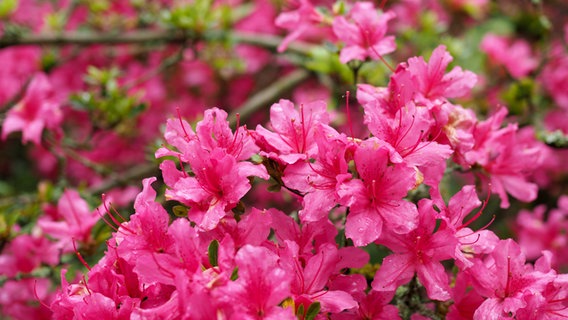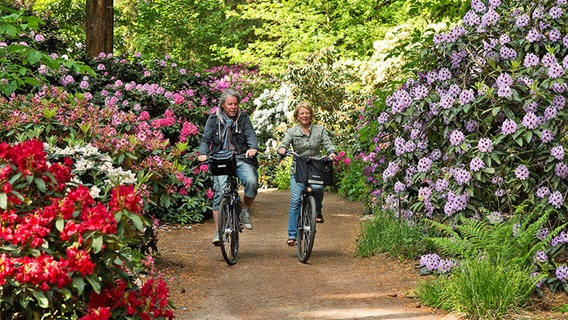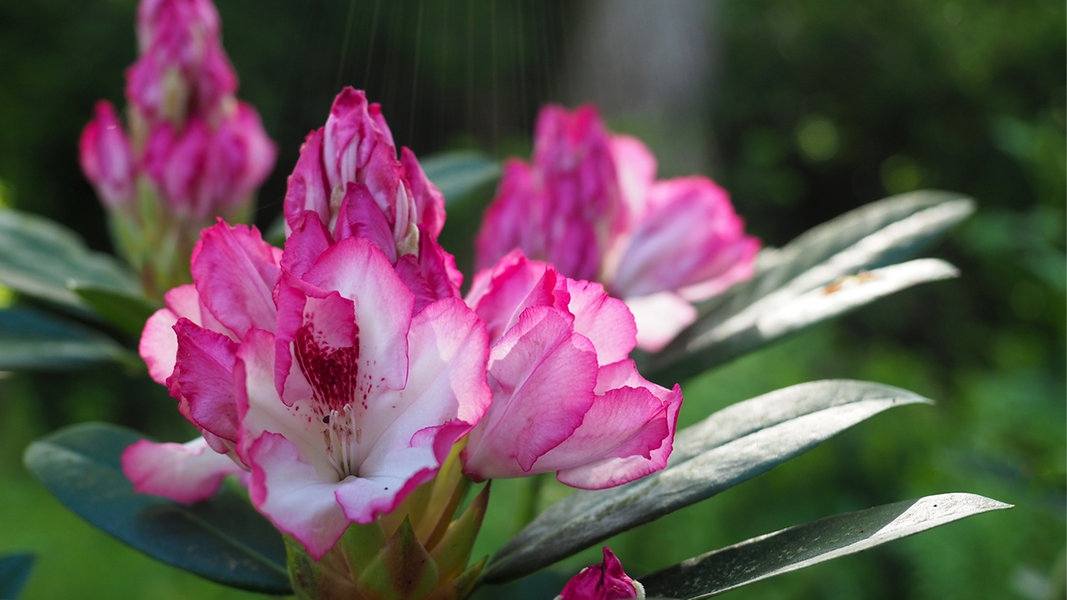
Planting, pruning and fertilizing rhododendrons correctly | NDR.de – Guide – Garden
Status: 24.05.2024 10:21 a.m.
To prevent rhododendrons from developing diseases, they must be planted in the right location. With good care, they can grow to be several meters tall. The plant usually does not need to be trimmed.
It blooms profusely in countless colors and can reach a considerable size over the years: Rhododendron, also known as Alpine rose. The predominantly evergreen plant, which botanically also includes azaleas, decorates many gardens. It usually blooms in April and May. There are also varieties that bloom in summer or autumn. Since all parts of the plant are poisonous, gloves should always be worn when gardening.
The right location: Where do I plant rhododendrons?

Rhododendron grows best in partial shade or light shade.
The location plays an important role in the health of rhododendrons. The plant only feels comfortable in light shade or partial shade. Rhododendrons are therefore ideal as a neighbouring plant to shade-giving trees. Some wild species, such as Rhododendron hirsutum, also tolerate a sunny location.
The dark green leaves look particularly attractive in combination with fine and light-leaved shrubs and perennials. Pretty companions are Hosta, foam flower, fairy flower, celandine and alpine bellflower.
Many different rhododendron varieties
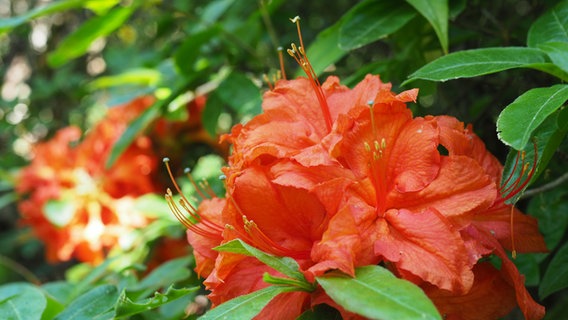
There are countless varieties of rhododendrons – including orange.
There are more than 1,000 species of rhododendron and countless varieties. They differ not only in the colors of their flowers, which range from white to dark purple, but also in their height and width. While classic rhododendrons can grow several meters tall and require a lot of space, dwarf rhododendrons (Rhododendron impeditum) and dwarf azaleas (Rhododendron obtusum) are ideal for smaller gardens and containers. Some grow no higher than 30 to 45 centimeters and are also suitable for rock gardens.
Planting Rhododendrons
The best time to plant rhododendrons is from April to mid-May and from September to mid-November. The bog plants have special requirements for the soil: it must be lime-free, loose, nutrient-rich and permeable to water, with an acidic pH value of 4.5 to a maximum of 6. Since many garden soils do not meet this acidity value, a special soil for rhododendrons is recommended.
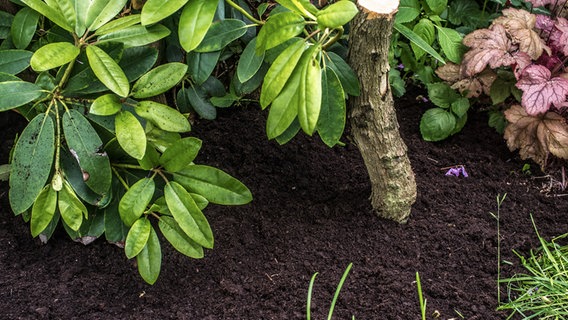
Special soil for rhododendrons ensures a low pH value.
Rhododendrons are so-called shallow-rooted plants and should not be buried too deeply. Therefore, dig the planting hole three to four times wider and a little deeper than the root ball and fill it with the special soil. This allows the plants to root in optimal soil for several years. Even if it is not easy: If the rhododendron has a lot of buds when planted, it is better to remove them. This will help it to grow better.
A layer of mulch up to three centimeters thick made of pine or spruce bark keeps the soil moist for longer and prevents weed growth. Since bark mulch causes nitrogen deficiency, horn shavings or bone meal should be added before the material is spread.
Caring for and watering rhododendrons
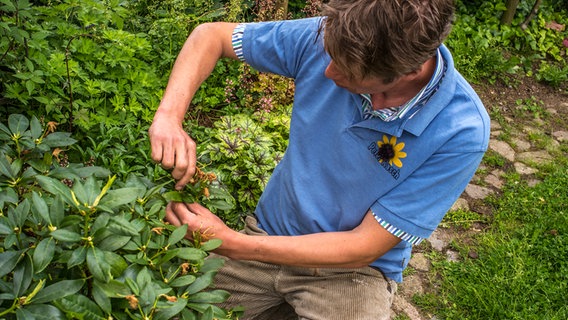
It is best to remove dead flowers to strengthen the plant.
It is best to use only rainwater for watering, as rhododendrons are sensitive to lime. Dissolving coffee grounds in the water helps against lime in water and in alkaline soils. They have a low pH value and are therefore particularly suitable for plants such as rhododendrons. Wilted flower heads from large-flowered rhododendrons should be removed. This prevents the plant from putting its energy into forming seeds. Instead, the energy flows into new leaves and flower buds. Also, regularly remove weeds around the plant.
The first fertilization takes place before flowering and the second with half the amount from the end of June to mid-July. A mixture of complete fertilizer and horn shavings in equal parts is recommended. A bush one meter high and wide needs about 100 grams of the mixture mentioned for spring fertilization. Small-leaved rhododendrons get by with half the amount of nutrients.
Further information
When and how do I prune rhododendrons?

Rhododendrons generally do not require pruning. However, they will sprout again from old wood.
In principle, it is not necessary to prune rhododendrons. If you do need to prune them, the optimal cutting angle is around 45 degrees (half a right angle) so that no water can collect on the cut edge. Since the so-called dormant buds are located directly under the tuft of leaves or the branch, the cut should be made under a branch.
Suitable months for pruning are the time before flowering, from February to early March, and the time after flowering, i.e. from the end of May, depending on the variety. Important: According to According to the Federal Nature Conservation Act, pruning is not permitted between March 1 and September 30, so it is only possible in early spring. Even if you prune the rhododendrons heavily, even down to the perennial wood, they will definitely sprout again. If you value a beautiful, round growth form, you can easily prune the rhododendron after flowering.
Detecting and treating rhododendron diseases
It is extremely annoying if the rhododendron shows signs of damage or stunted, brown foliage instead of lush green leaves. Unfortunately, even the most perfect location is no guarantee that the plant will remain healthy for life. Diseases can be identified most quickly on the leaves and buds – the diagnosis is usually clear.
Rolled up leaves on the rhododendron – a sign of dryness
A typical sign of dryness is rolled-up leaves. The rhododendron tries to protect itself by reducing the evaporation area. This can also happen in dry winters. Targeted watering of the root ball usually helps quickly.
Yellow leaves indicate nutrient deficiency

Yellowish leaves with a green bone pattern indicate iron deficiency.
Yellow leaves on rhododendrons are usually a sign of a lack of nutrients. If the leaves are yellow all over, the plant is usually lacking nitrogen. If the leaves also have a green herringbone pattern, there is a lack of iron. The cause of this is too high a pH value in the soil, which can also be caused by watering with calcareous water. The rhododendron is then unable to absorb the nutrients in the soil.
A special rhododendron fertilizer from a specialist retailer will provide the plant with the nutrients it is missing in the short term. In addition, the soil should be improved with special soil for rhododendrons. If this does not help, it is better to replant the plant in a suitable location.
What to do if there is fungal and mold infestation?
If the leaves turn brown at the edge or tip, the rhododendron is suffering from a fungal infection, known as leaf spot disease. Often the only solution is to use an anti-fungal agent (fungicide) that is specifically tailored to the infection. If a greyish layer appears on the leaves, grey mould has struck. This occurs mainly in very humid and warm weather. A special fungicide can help here too. Dispose of fallen leaves in the household waste.
Rhododendron cicada causes black-brown buds
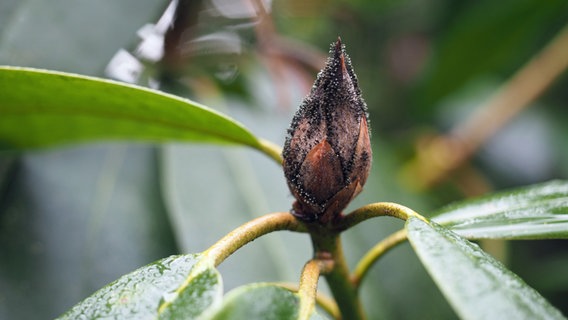
The affected buds must be collected and disposed of in household waste.
Black or brownish, dried buds with dark hairs on them are the result of an infestation by the rhododendron cicada. The pest insect stings the bud and lays its eggs there. The piercing also causes a fungus to penetrate deep into the bud. First measure: collect all infected buds and dispose of them in the household waste. This reduces the infestation by the next generation of cicada.
The greenish-yellow larvae of the cicada usually hatch in May and can be found on the undersides of the leaves. Regularly spraying the leaves with neem oil is said to help biologically combat the pest. Sprays against sucking and biting insects combat the cicada chemically. A more natural way to combat this is to use so-called yellow sticky sticks, which the insects stick to.
Combating the common vine weevil
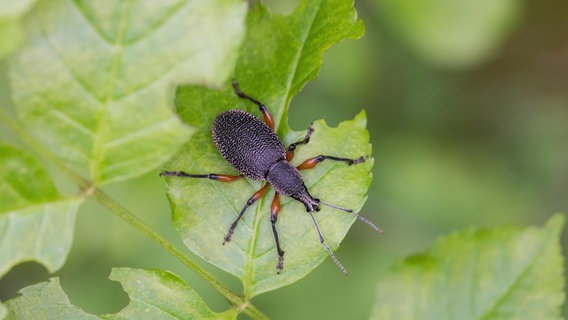
Leaves with gnawed edges indicate an infestation by the black vine weevil.
Leaves with gnawed edges are an unmistakable sign of the common vine weevil. The most dangerous are the larvae of this nocturnal animal, because they live in the soil and eat the roots. An effective way to combat this is to use upturned clay pots placed in the root area. During the day, the vine weevil uses these as a hiding place and is easy to collect. Threadworms, so-called nematodes, help against larvae. These natural enemies penetrate the pests and eat them. Nematodes are available from garden retailers and are completely harmless to humans and animals.
Leaf burns on hot days can be avoided by watering only in the early morning and late evening and never pouring water directly over the leaves.
Further information


Ethel Purdy – Medical Blogger & Pharmacist
Bridging the world of wellness and science, Ethel Purdy is a professional voice in healthcare with a passion for sharing knowledge. At 36, she stands at the confluence of medical expertise and the written word, holding a pharmacy degree acquired under the rigorous education systems of Germany and Estonia.
Her pursuit of medicine was fueled by a desire to understand the intricacies of human health and to contribute to the community’s understanding of it. Transitioning seamlessly into the realm of blogging, Ethel has found a platform to demystify complex medical concepts for the everyday reader.
Ethel’s commitment to the world of medicine extends beyond her professional life into a personal commitment to health and wellness. Her hobbies reflect this dedication, often involving research on the latest medical advances, participating in wellness communities, and exploring the vast and varied dimensions of health.
Join Ethel as she distills her pharmaceutical knowledge into accessible wisdom, fostering an environment where science meets lifestyle and everyone is invited to learn. Whether you’re looking for insights into the latest health trends or trustworthy medical advice, Ethel’s blog is your gateway to the nexus of healthcare and daily living.

